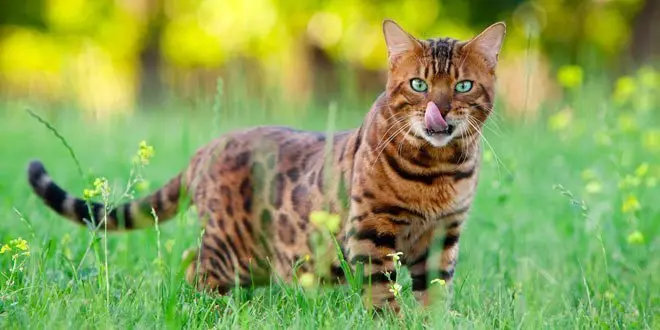Are you thinking about adopting a Bengal cat? Perhaps you already have one of your very own that you’d like to get to know more about?
Before buying this breed, make sure you know all the important Bengal cat facts.
From their price range to personality, we’ve got all the Bengal cat facts you should be aware of about these fiercely lovable felines.
Check out the following Bengal cat facts that are sure to me-wow you!
The Top 10 Brilliant Bengal Cat Facts to Know Your Feline Friend a Little Better
1. Where These Cats Come From–Wild & Wonderful DNA
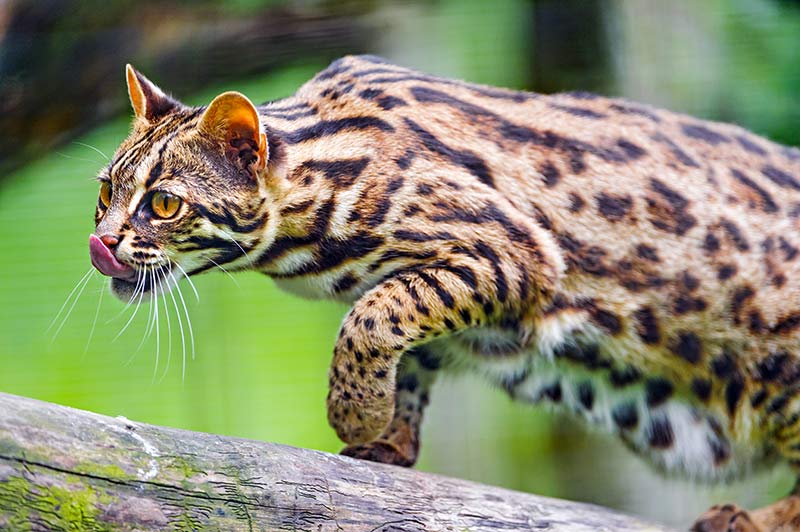
First thing’s first, where do these cats even come from? The first of our Bengal cat facts will answer this question with the brief history of Bengal cats.
Here are the Bengal cat facts you need to know about how these cats came about:
[tie_list type=”checklist”]
- Domestic Bengal cats come from hybrids, a cross between the Asian Leopard Cat and a domestic cat.
- Documentation of the hybrid reaches back as early as the 1800s.
- Various people developed the Bengal breed.
- Jean S. Mill was the most notable developer of Bengals. Through careful breeding in the 1970s and 80s, Mill had the aim of harnessing the beauty of the wild cat while maintaining the temperament of the domestic cat. (And she nailed it!)
2. They Can be Controversial Cats
Unfortunately, one of the sad Bengal cat facts is that they’re not greeted with open arms from all.
While their descent makes them unique and intriguing, the wild and wonderful DNA of Bengal cats also makes them controversial in some circles.
By 1985, Jean Sugen Mill had bred numerous Bengals. She then began to show them at cat shows hosted by The International Cat Association (TICA)–one of the world’s largest registries of pedigreed cats.
However, kind greetings weren’t waiting for the new kitties. Instead, cat breeders protested.
Some cat breeders complained it was dangerous to show cats descended from non-domestic wild animals, while others claimed that it was unethical to breed threatened or endangered wildcats with domestic ones.
Although the new feline wasn’t accepted by all, the exotic cat still managed to find fans. Clubs such as The International Bengal Cat Society (TIBCS) were formed to celebrate the breed.
3. What Bengals are Known For
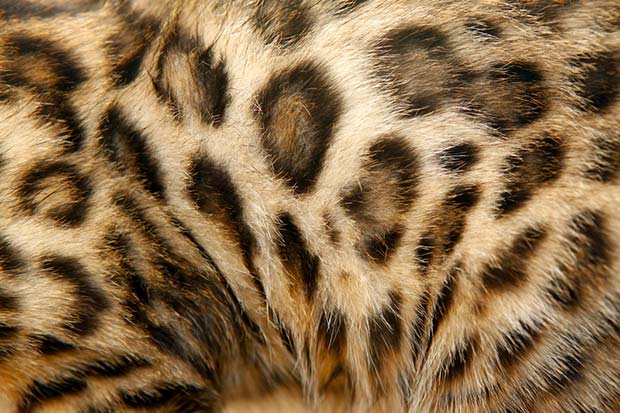
What’s the first thing you and many people notice about the Bengal cat? Most likely, your answer is their wonderful coat.
One of the better known Bengal cat facts is that these kitties have crazy cool coats!
The Famous Bengal Markings
Bengals are known for their distinctive spotted or “marbled” fur.
Bengals have two basic fur patterns. These include the spotted pattern, which is more common, and a less common swirly marbled pattern.
Both the spotted and marble fur patterns are often tri-colored and have various shades throughout that form the unique markings.
It’s this tri-coloring that gives spotted Bengals “rosettes.” These cats have several different types of rosettes, and those rosettes are in different stages of development on each cat.
A rosette is where each individual spot has an outline of a darker color. This is what gives Bengals a similar look to that of a Jaguar or Leopard.
Not all Bengals have defined rosettes. Some have spots that appear more like a Cheetah, with no outline of color.
Other Bengal Cat Coat Characteristics
No two cat’s markings are exactly alike.
The most popular Bengal cat colors are brown/black. However, these cats can come in a variety of shades, including black and silver, snow (white), charcoal, and blue.
Not only is it beautiful visually, but the Bengal cat coat is also very soft and sleek.
Because of this, Bengals “glitter.”
That’s right, their distinctively patterned fur is short, silky, and often “sparkles” at the tips! You can see this with many Bengals who seem to shine in the light as it permeates through their hair shafts.
4. How Bengals Feel About Water
While the threat of getting wet sends most cats into a frenzy of fear, leaving them clamoring for cover, Bengals, on the other hand, love water!
These water-loving felines will gladly drink directly from the tap if allowed.
Don’t find it strange if your Bengal follows you right into the shower or bathtub, as this is even a common habit of some Bengals, believe it or not.
If you’re looking for a little alone time when bathing, close the door but be prepared for some major meowing and complaining from your Bengal.
5. Bengals Get Bored
The image that comes to the mind of most when talking about domestic cats is those furry felines laying in the sun, snoozing the day away.
However, Bengals are not typical house cats.
One of the most important Bengal cat facts to know about your feline friend is that they need entertainment. This breed is very smart, and they require a lot of attention and the right toys to keep them occupied.
What do we mean by the right toys?
Good old stuffed mice won’t do the trick for these guys. Toys with puzzles to solve are best for the curious Bengal breed.
Keep in mind that if you don’t provide your Bengal with adequate entertainment, he’ll find ways to make his own fun. This can include destroying your electronics or getting into and/or damaging things he/she shouldn’t.
6. These are Some Costly Cats
Adopting a Bengal cat often means big bucks.
If you want to purchase a Bengal, start saving up, as fans of the breed can pay anywhere from hundreds of dollars for a “pet” quality Bengal to thousands for a show-quality one.
A “pet” quality Bengal simply means it’s not a kitty meant to be exhibited at shows.
There’s even a rumor that one British woman paid over $50,000 for her Bengal in 1990. This kitty was then known as the “Roll’s Royce” of cats.
7. Bengals are Active & Athletic
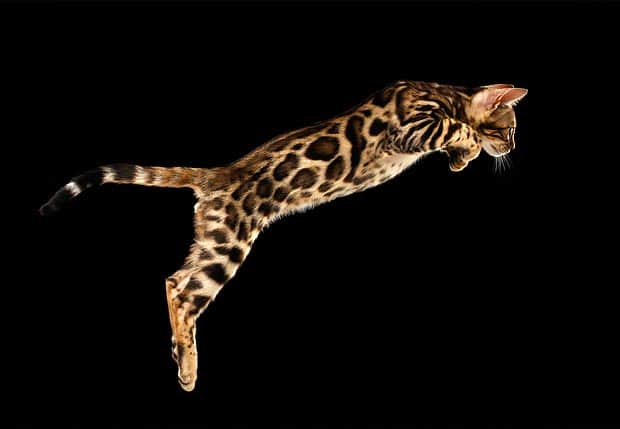
While Bengals may look like wildcats, they’ve been bred to have the personality of a typical house cat.
Bengal owners are known to describe their cats as intelligent, vocal, and very active.
Bengals are excellent jumpers and climbers as well.
They love to climb on furniture, leap up onto high surfaces, splash around in bathtubs and sinks–they even love a great game of fetch. That’s right, pups, fetch is for felines as well!
This means, if you’re looking for a lazy lap cat or docile pet, the Bengal isn’t the one for you.
On the other hand, however, if you’re an energetic person who can keep up with a highly active cat, these kitties might be just the companion for you!
This breed would work best with those with a high-intensity lifestyle.
8. You Can Teach Tricks to Your Bengal
One of the better known Bengal cat facts is that this breed is highly intelligent. They are also hungry for attention.
Because of these characteristics, these are among the easiest cats to train.
We’ve already mentioned that Bengals can play fetch. This is one example of a simple trick to teach Bengals.
Another example of an easy trick you can teach your Bengal is how to turn on and off light switches.
9. Bengals Love…
Stealing
If you’re having a hard time finding your car keys, your Bengal just might be the culprit.
Some Bengals can be little thieves.
These cute crooks tend to do whatever they please with whichever objects throughout your home grab their interest.
This means, don’t leave important items laying out as fair game. Instead, keep your Bengal out of your things by offering him/her plenty of cat-friendly toys.
The Leash
Bengals love the leash. Unlike most adult cats, who will likely leave you with several scratches if you try to put a leash on them, Bengals are much easier to leas-train.
This even holds true with Bengal adults–who says an old cat can’t learn new tricks?
It’s recommended that Bengals mostly remain an indoor pet, due to their tendency and ability to hunt birds.
However, you can allow your Bengal to explore the outdoors safely if you train your feline friend to walk on a leash.
Talking
The Bengal breed is very vocal. These talkative kitties can also be remarkably loud when they want something.
A Bengal will surely let you know when it’s time for dinner or he/she wants to play.
With that being said, however, Bengal meows can also be adorable, expressive, and fun to hear.
10. Beautiful Bengal Physical Features
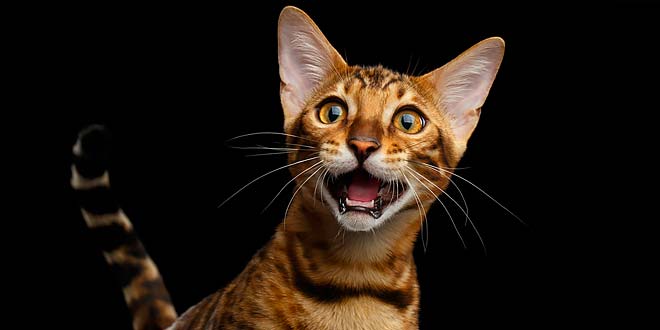
Size
One of the Bengal cat facts you should surely be aware of before buying a Bengal is their size.
While Bengal babies, like any other kitties, will be small at first, these guys can get quite large.
Male Bengals weigh between 10 to 15 lbs on average. Females will weigh in around 8 to 12 lbs, usually.
Of course, don’t be surprised if you get some even bigger than that, or find a few who are smaller too. So, don’t be concerned if your Bengal is outside of those averages.
Head, Ears & Eyes
Other interesting Bengal cat facts include these physical features of this beautiful breed, which include the following:
- Head: The head of the Bengal should be quite small in comparison to the body.
- Ears: Bengals will have small ears too. This is reminiscent of their wild cat ancestry.
- The ears should also have a “thumbprint.” This refers to a patch where the fur is very short, in the shape of a thumb.
- Eyes: Bengals typically have large oval eyes that are green, gold/yellow, or aqua/blue.
[/tie_list]
While these Bengal cat facts may be new to you, we want to hear your own unique Bengal cat facts if you have a kitty of this breed! Tell us about different characteristics of your Bengal.
Is your Bengal a perfect example of all the Bengal cat facts described above, or is he/she different in various ways? Comment below!
[products limit=”3″ columns=”3″ orderby=”id” order=”DESC” visibility=”visible”]

